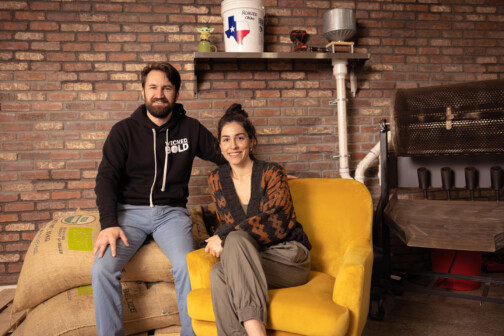 |
| EASY BEING GREEN: Dan Fette stands before the affordable, energy-efficient homes, a concept he helped pioneer. |
Just east of interstate 35, about a mile south of central Denton, big-box stores anchor nondescript strip centers surrounded by seas of adjacent parking. Like anywhere in the country, mothers, fathers, and children have made the short trek from their subdivisions to this no-longer-new marketplace, where the big boxes once impressed but now have become mundane. This is the model of American development that took off in the years following World War II, when G.I.s with fresh families moved out of the cities they grew up in to find affordable homes cropping up on abandoned corn fields.
For decades this flourishing pattern of strip centers accompanied by subdivisions of quickly built housing have given shape to the communities and environments in which we live, defining our culture, habits, and expectations. But in recent years this model has also come under attack by critics who point to the glut of resources needed to sustain the system.
These criticisms first reached the popular discussion in the late 1970s, around the time Jane Burda Provo, the executive director of the Denton Affordable Housing Corporation, was working on her master’s degree thesis. Provo studied the impact of residential energy conservation on quality of life. Specifically, she wanted to know how much of his or her quality of life the average citizen was willing to sacrifice in order to conserve gas, water, electricity, and the like.
“Sadly, at the time, people weren’t willing to do much,” Provo says. “Putting a sweater on was one thing, but if you had to curl up on the couch with a blanket because your house was so cold, that was another thing.”
| ›› THE TAKEAWAY |
1. People like green houses, but they really like well-built houses. 2. Low-tech solutions are just as good as more expensive ones. 3. Old habits sometimes stand in the way of new ideas. |
It was a lesson Provo didn’t forget, even though the 1980s and 1990s brought a renewed abundance in cheap oil and natural gas, and the United States drifted back into the comforts of sprawl life. After September 11, the Iraq War, Hurricane Katrina, and now Al Gore’s traveling environmentalist road show, the popular attitude has once again shifted.
Green is in vogue, hip, and on everyone’s mind. Two years ago Provo decided to take advantage of the popular resurgence in green living to try to realize a lifelong dream: creating an affordable housing project that was energy-efficient and environmentally friendly.
“Now it has become in the forefront of public attention, and green and efficient kinds of living are catching hold again,” Provo says. “I think timing is critical.”
An affordable green house may seem like an oxymoron. Green technologies (solar panels, water reclamation systems, geo-thermal heating) are notoriously expensive and have unintentionally slapped the green building movement with an elitist reputation.
That was something Denton builder Dan Fette, who heads the Home Builders Association of Greater Dallas’ Green Built North Texas program, experienced firsthand when he was working as a superintendent on the nationally acclaimed zero-energy home in Frisco. Though a modern engineering marvel, the home’s final price tag came in at over $750,000.
“When I was done, I bragged to all my friends,” Fette says. “But when I bragged, they said, ‘Come back and brag when you can do something the rest of us can afford.’”
As far as Fette knew, no one in the United States had tried, let alone succeeded, in making green houses for lower incomes. So when Provo approached Fette with exactly that challenge, Fette was hooked.
“I jumped at the opportunity,” Fette says. “I got fired up immediately.”
The irony of blazing that new trail at a location within the sprawl of Greater Dallas seemed the perfect opportunity.
Provo spotted a section of land past the strip malls and behind the 1960s subdivision near Loop 288 one mile south of Denton. The setting could make another point about quality of life: that a subdivision of affordable, energy-efficient homes would not look out of place in the kinds of neighborhoods that already exist throughout the Dallas suburbs—that they didn’t need to look like they were green.
 |
 |
| GREENHOUSE EFFECT: Jane Burda Provo approached Dan Fette about making green homes for those with lower incomes, like those pictured above. |
“That’s something we’ve prided ourselves on,” Provo says. “It doesn’t need to look strange or unusual at all and can still be very green.”
Newly paved Paisley Street runs due east along an adjacent meadow. A typical visitor wouldn’t think twice about the unassuming 14 new homes that make up the Nevada Court housing development.
“They look just like regular homes,” Provo says. “Only prettier,” Fette chimes in.
The single story, contemporary ranch-style homes are conspicuous only in their inconspicuousness. Most feature quaint, if plain, brick exteriors, with a two-car garage sitting to the right of the front entryway. In one home, a hall leads into an open living, dining, and kitchen space, lit primarily by a large window that frames a grassy back lawn and newly planted garden cared for by a neighbor. There are no solar panels on the roof, no gurgling pipes or geothermal coils; the roof is laid with light-colored composition shingles, not grass, pitch, or recycled tires.
Save a large, curious black plastic basin that sits discretely adjacent to the back corner of the house, nothing at all is out of the ordinary.
Here’s the first lesson of the Denton Affordable Housing Corporation’s new green subdivision: The easiest way to build a green house is to build a well-built house. It was a discovery Provo and Fette made when they first began researching various energy-saving technologies.
“We found we could achieve a similar level of efficiency without having to invest in some of the more cutting-edge kinds of technology and mechanical systems,” Provo says. “With just really, really good building techniques, which doesn’t add a lot of expense but does necessitate a lot of observation and supervision, we could achieve a huge level of efficiency.”
In short, there are three basic techniques that Fette brought to these homes to increase their energy efficiency. First, he built them as air-tight as possible, using an air-tight dry wall approach, to make sure that there weren’t invisible leaks in the structure.
The second building strategy was making sure all the air-conditioning and heating duct work was run within the air-conditioned space in the house, as opposed to the attic. To do this, Fette designed the homes so that the main living areas and the bedrooms would have nine-foot ceilings, but the hallways would be 14 inches shorter to allow room for the ducts.
Finally, the footprints of the homes are all laid out so that the fronts face due north and the rear due south. “For the most part, we tried to nearly eliminate windows on the east and west side, and doors as well,” Provo says. “So that the sun, that early morning and late afternoon sun, is not bringing the solar and radiant heat into the homes.”
As the seasons change, and the sun drops lower in the sky during the fall and winter, Provo explains, more sun rays shine through the large, south-facing window, allowing for welcomed radiated heat to enter the home.
“We could have invested in lots of bells and whistles, but this really achieves fabulous efficiencies,” Provo says. “It’s low-tech.”
 |
| Jane Burda Provo photography by Elizabeth Lavin |
With these three major energy-saving techniques built into the homes’ design, achieving additional efficiencies was just a matter of putting together the most complementary and affordable package of smart technologies.
To cut down on water usage, the homes have special low-flush toilets (“That actually work,” Fette emphasizes), low-volume shower heads, and a small pump that pushes hot water to the sink faucet without having to run the tap, saving about two gallons of water each time you wash your hands.
All the lights have various styles of fluorescent bulbs, and all the major appliances in the house are Energy Star grade, an initial, extra expense that quickly shows a return thanks to lower energy usage.
Because the home is air-tight and doesn’t allow for excess solar radiation to heat the interior space, Fette was able to install a smaller air-conditioning unit. Fette also installed exhaust fans in the laundry room as well as above the stove to control humidity. He designed the air intake for the air-conditioner to help cut down on the humidity through the natural condensation caused by the freon coils. Keeping the air in the house drier also means that residents feel comfortable at 80 degrees, rather than using extra energy to cool down to 75 degrees. The air-conditioner also heats the home by running hot water from the water heater through coils to serve as a heat source. Coils also heat hot water for space heating.
“We’re estimating that the additional amount of natural gas needed to heat that additional amount of hot water to provide for space heating is maybe $40 a month,” Fette says. “So you are heating a home for $40 a month.”
For the most part, the homes create efficiencies with smart, low-tech gizmos, with one exception: the water reclamation system, which collects every drop of water that falls on the roof into a huge, 1,550-gallon basin located in the rear side of the house.
“In this part of Texas, we estimate that 40 to 50 percent of water use arises just from people watering their lawns,” Fette says. “We have put together a landscape package that is drought-tolerant and doesn’t need much water. The tank capacity is capable of meeting—in an average rainfall year—all of the water needs.”
Combined with the water-saving technologies inside the house, Fette estimates the Denton Affordable Housing Corporation homes will use around half the water of the average house in the area.
Why wouldn’t everyone want a home that, according to Fette’s estimates, will cut water use by 50 percent and dropping the average bill for heating and cooling to less than $50 a month?
For one thing, the project is a bit of an anomaly.
Provo says the goal was to build a home within the reach of individuals or families making 80 percent of the area’s median income. To keep costs down, they didn’t hire a general contractor and priced the homes to cover Denton Affordable Housing’s administration costs, barely making a profit. In addition, many of the products used in the home were purchased at a discount from suppliers who wanted to be associated with the ground-breaking initiative.
In the end, Provo says they are able to place the mostly 1,200-square-foot, three-bedroom, two-bath homes on the market for around $130,000. But despite the many corners the non-profit development was able to cut to keep costs down, Fette says many homebuilders around the country are moving toward building greener homes.
“McGraw-Hill did a market study and concluded that we should expect to see in the next six or seven years green, energy efficient– related construction up in the range of $19 to 38 billion a year from about a $7.4 billion,” Fette says.
Fette says the largest obstacle to a greater proliferation of green building is simply breaking old habits.
“Builders do it the same old way because you are in a hurry and a builder has to guarantee his work,” says Fette, who helped release a technical resource guide for green building in April with Green Built North Texas. “[A builder] doesn’t like brand-new stuff that he is doing for the first time and doesn’t know if he is going to get right the first time.”
Municipalities are also slow to embrace the improvements of green building. Fette says Denton still charged the fees associated with bringing full-capacity sewage lines, even though they had the data to prove a decrease in water runoff from the project of around 75 percent.
But Fette and Provo are hopeful those attitudes will change. And now that they have shown green building can also be accomplished at a reasonable cost, at least they don’t plan on stopping the trend.
“We’ve started a good thing and we need to continue,” Provo says. “Were we not [to continue], it would send a very wrong message out into the public, and it would be doing the folks we serve a disservice.”
WHAT MAKES A GREEN HOUSE GREEN
As Fette’s homes show, going green and increasing energy efficiency doesn’t have to mean investing thousands of dollars in fancy technologies. Simple solutions can lead to dramatic results. Step one, though, is finding your base line: Get an energy audit. The United States Department of Energy has a Web site that can walk you through a do-it-yourself audit (http://hes.lbl.gov). Or for a
cost of about $100 to $300, you can have a professional review your home for inefficiencies or areas where you can improve your home’s ability to retain energy. Also check with your utility company; some offer free energy audits. Then, try some of these tips:
1. The no. 1 energy saver utilized in the Denton Affordable Housing Corporation project was placing the air-conditioning units within the air-conditioned space. Also, Fette says most houses experience 20 to 30 percent air leakage in their air-conditioning system. One way to achieve the same effect without major remodeling is to spray your duct systems with a polyurethane foam, which will both seal and insulate the system.
2. Although it seems very low-tech, weather stripping— making sure your doors and windows close tightly—can have a huge effect on keeping your home the temperature you want.
3. Look in your yard and try to introduce drought-tolerant plant varieties to your landscaping. There are dozens of native grasses, plants, and flowers that won’t detract from the aesthetics of your home while saving you tons on your irrigation bill.
4. Programmable thermostats are not expensive, and they are a simple way of making sure your home temperature stays comfortable without having to constantly start up and shut down your air-conditioning unit.
5. Shade your windows. Allowing the hot Texas sun to pour into the living room will likely force your air-conditioner to work overtime.
6. The rainwater catchment system included in the Denton Affordable Housing project, which collects rainwater into a huge 1,550-gallon basin, runs around $5,000, which means it may take a few years to reclaim your cost benefit. But the system also means that you should never have to pay for a single drop of irrigation water used on your landscaping again.
7. New low-flush toilets run between $150 and $175 and offer two flush volumes for liquid and solid waste. The models have improved over the years and can now handle up to 350 grams of solid waste while using only 1.6 gallons of water.
8. A simple shower head that costs $45 will drop your water usage to less than 1.75 gallons of water a minute.
9. In the Paisley Street homes, Fette installed a small pump that feeds hot water directly to the faucet without having to first run the water, saving about two gallons of water every time you wash your hands. The pump costs $300 plus installation charges.





